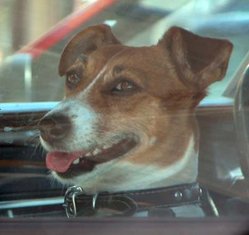
|
From Wikipedia the free encyclopedia, by MultiMedia |
| Jack Russell Terrier | ||
|---|---|---|

Jack Russell Terrier
|
||
| Alternative names | ||
| Country of origin | ||
| England | ||
| Common nicknames | ||
| Classification and breed standards | ||
| FCI: | Group 3 Section 1 #345 | |
| ANKC: | Group 2 (Terriers) | |
| NZKC: | Terrier | |
| UKC: | Terriers | |
| Not recognized by any major kennel club | ||
| This breed of Dog is extinct | ||
| Notes | ||
| Some kennel clubs consider this the same as a Parson Russell Terrier. | ||
The Jack Russell Terrier is a type of small terrier that has its origins in fox hunting. The name "Jack Russell" has been used for all of the several types of Russell terrier but is now most commonly used for working terriers similar in form to Parson Russell Terriers. The Parson Russell Terrier itself was known as the Jack Russell Terrier in the United States until 2003. In England the name has been used to refer to the Parson Russell Terrier and to the short-legged type, the Russell Terrier. In Australia and other countries affiliated with the Federation Cynologique Internationale (FCI) a fourth type, the Australian Jack Russell Terrier, is also talked about but official name is Jack Russell Terrier. These types are not always considered to be separate breeds, definitions are still evolving and the naming of the breeds is still sometimes unclear.
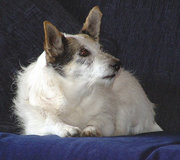 Broken coated JRT
Broken coated JRT
All Russells are small terriers; Jack Russell Terriers vary between 25 and 30 cm at the withers and Parson Russell Terriers are between 32-38 cm.
They are predominantly white with black, tan, or tricolour markings, particularly on the face and the base of the tail. They have small V-shaped ears that usually fold sharply forwards, and strong teeth with a scissor bite.
They have a dense double coat that appears in three varieties: smooth coat, where the topcoat is very short (approx. 1cm) and stiff; rough coat, where the topcoat is longer (as much as 10cm long, though usually groomed shorter); and broken, which is used to describe both Dogs with topcoats of intermediate length and Dogs that have longer coats only on some parts of the body (always on the face, frequently on the head and back, sometimes extending to the shoulders, occasionally everywhere except the legs).
Although tail docking is banned in most countries, tails are often seen docked to about four inches (100 mm) long and held high and upright. When not docked, the tail should be straight for show Dogs.
The breed has a sturdy and robust appearance and an outgoing character; breed standards emphasize that the Jack Russell must have a 'keen expression'.
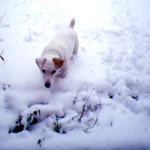 Jack Russells make excellent pets for the right owners.
Jack Russells make excellent pets for the right owners.
Jack Russell Terriers are considered an intelligent, high-energy breed. Their compact size, friendly and inquisitive nature, and intelligence make them popular as pets. Built for speed and strength, they will always be ready to play. However, they require consistent training and a good deal of attention and exercise to maintain their temperament and to occupy their minds. Jack Russells who are not trained on a consistent basis, or are not exercised regularly, may occasionally exhibit aggressive or unmanageable behaviour, including excessive barking, escaping from the yard, or digging in unwanted places inside and outside the house. In America, several Jack Russell rescue networks have to work constantly to find temporary and permanent homes for JRTs whose owners could not meet these requirements for keeping JRTs as house pets.
They will bark if startled by a sound, which makes them a good security system.
A well-cared-for Jack Russell can live for over 15 years.
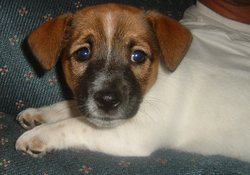 A young Australian Jack Russell
A young Australian Jack Russell
Russell terriers were first bred by the Reverend Mr. John Russell, a parson and hunting enthusiast born in 1795. In his last year of university at Oxford he bought a small white and tan terrier bitch called Trump. She was the basis for a breeding programme to develop a terrier with high stamina for the hunt as well as the courage and formation to chase out foxes that had gone to ground, but without the aggressiveness that would result in their harming the fox, which was considered unsporting. The line of terriers developed by John Russell was well respected for these qualities and, when he died in 1883, his Dogs were taken on by other hunt enthusiasts.
The first split between the types of Russell terriers may have occurred early in their history with Dogs being sold by the sister of John Russell's kennel man. These she described as "Jack Russells" but they may not have been part of the line of terriers developed by John Russell. Instead they may have been shorter-legged working terriers of variable heritage. Later, around the turn of the century, the secretary of the Parson Jack Russell Terrier Club bred a strain of terriers for badger digging. These needed the brave character and endurance of the Jack Russell Terrier, which were crossed with Bull Terriers to give a stronger and harder Dog with shorter legs than the original type. Again these were described as "Jack Russells".
Along with these changes the Second World War had a great impact on the breed. Sporting Dogs were needed less and the numbers of working Russell terriers were drastically reduced during these years. The original working Russells often became family Dogs and were crossed with other popular family Dogs including Corgis, Chihuahuas and terriers such as the Fox Terrier and the Staffordshire Bull Terrier. These crosses resulted in changes in form and function and led to a new type of short-legged terrier with a variable conformation. It is this form of the descendants of Trump that are now known as "Russell Terriers", "shortie Jacks", or "Puddin' Dogs".
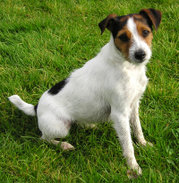 Parson Russell Terrier
Parson Russell Terrier
The original longer-legged forms were also preserved and, in England, were called "Parson Jack Russell Terriers". This form was recognised by the Kennel Club (UK) in 1990 and gained provisional recognition by the international breeds association, the F.C.I, in the same year. The name of the breed was changed to "Parson Russell Terrier" in 1999 by the Kennel Club (UK) and gained full recognition by the F.C.I under this name in 2001.
In the United States a group of enthusiasts opposed to the registration and regulation of the working breed registered "Parson Jack Russell" as a trademark. This led to the long-legged breed being recognised by the American Kennel Club under the name "Jack Russell Terrier". This name was changed to the "Parson Russell Terrier" in 2003 to conform with the nomenclature in other countries. Breeders of the unregistered, working strain continued to use the Jack Russell name for their Dogs. Currently there are few differences between the two types, although working Jack Russell Terriers are sometimes smaller than Parson Russell Terriers. However, it is likely that the differing approaches to breeding and the restricted gene pool of the registered type will result in divergence between the types, possibly leading to two very different breeds.
In England, the Kennel Club recently re-opened its registry to allow the inclusion of some Jack Russell Terriers under the Parson Russell name. The standard was extended to include slightly smaller Dogs to about 10 inches (25 cm) high but still with the longer-legged form. Individuals registered with the Jack Russell Terrier Club of Great Britain or the British Jack Russell Terrier Club and with registered parents and grandparents were accepted for registration. This may have a delaying effect on any divergence of the two types, but many breeders remain opposed to registration and are likely to continue to breed outside the Parson Russell standard and to continue to use the "Jack Russell Terrier" name.
The working strains of Jack Russell Terriers are not recognised by the FCI, or by any major registry. Some breeders have campaigned for recognition either as part of the Parson Russell Terrier breed or separately. However, other breeders, such as the Jack Russell Terrier Club of America, feel that this working breed should not be restricted by the standardisation and limits to breeding that this would involve. Most large registries recognise and register only breeds that they regard as "purebred", that is, Dogs who breed true to form, within a set standard, and whose parentage is known to be of other examples of the breed meeting these criteria. For working-terrier enthusiasts this may not always be acceptable. They want to breed for function rather than form, which might include using Dogs of variable ancestry to improve the working abilities of the offspring.
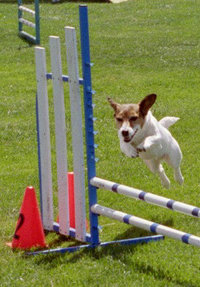 Jack Russell (short legs) excelling at Dog agility
Jack Russell (short legs) excelling at Dog agility
In 1990 Jack Russell Terriers were given full recognition by the Australian National Kennel Council. The FCI followed with recognition in 2001. This breed is sometimes called the "Australian Jack Russell Terrier" to distinguish it from the other forms of Jack Russell terriers found in other countries. Its form is very similar to the Parson Jack Russell and to working Jack Russell Terriers, although its standard form is for the body to be longer than it is tall. This gives it a form somewhere in between that of "shortie" Jacks and the taller formation of other Jack Russell Terriers and of Parson Russell Terriers.
Because of the recent nature of these changes there is still considerable variation in the names used for the different types of Dog. Additionally, controversy over registration, conformity to set standards and breeding restrictions may still lead to other variations in the naming and classification of these Dogs.
The Jack Russell's endearing facial expressions, feisty personality, and cuteness make it a natural choice for television and the cinema. Some famous Jack Russells include Wishbone, the title character of a popular children's television series in the United States, Milo from the hit movie The Mask played by Max, Rimshot from the comical Ernest P. Worrell movies, and Bijoux the policeman-hating Dog from Hooperman. There was even a Jack Russell in the movie Crimson Tide, and in the movie the character played by Gene Hackman introduced the Dog breed as one of the smartest in the world.
Some Jack Russell Terriers have near-superstar status, including Eddie, the clever, irrepressible Dog belonging to character Martin Crane on the sitcom Frasier. Eddie was played by a Dog called Moose, but later in the series, Moose also had a stunt double; his son Enzo stepped in for the more physically demanding tricks to spare his aging sire. Moose and Enzo also appeared in the movie My Dog Skip. Also prominent is Soccer, the Dog star who portrayed Wishbone, a veteran performer with many television commercials to his credit. He reportedly hated swimming and had two stunt doubles and a body double.
Superman's Dog, Krypto, in the older DC Comics's Superman comic books, was possibly a Jack Russell Terrier. The Dog which accompanies Rick Stein on his ventures is a Jack Russel Terrier, named "Chalky".
Jack Russell is also the name of the protagonist of Radiata Stories.
Dogs, made by MultiMedia | Free content and software
This guide is licensed under the GNU Free Documentation License. It uses material from the Wikipedia.